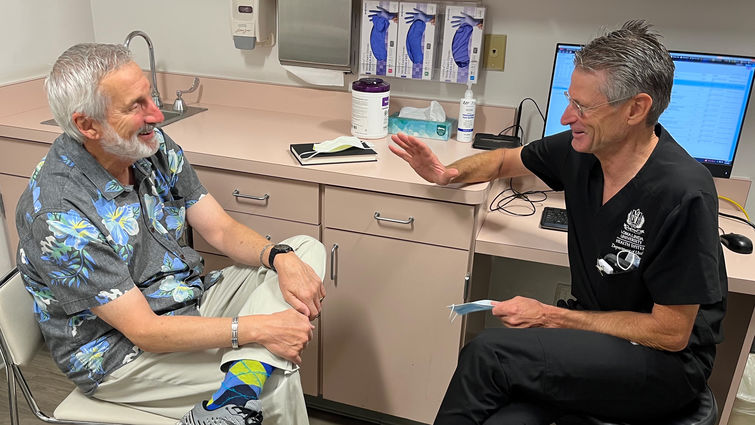
Urologist Herbert Ruckle, MD, ensures patients obtain access to factual information about prostate cancer.
Health misinformation can impact the decisions people make and even the course of their lives. When it comes to prostate cancer, deciphering myth from fact is key to making informed, best medical practice, data driven, healthy decisions in a journey spanning screening to diagnosis and treatment.
Herbert Ruckle, MD, FACS, chair of Loma Linda University Health’s Urology Department, says many myths and legends surround prostate cancer. During September’s Prostate Cancer Awareness Month, Ruckle busts two common myths related to the disease.
Myth #1: “I don’t need to be screened because I will know I have prostate cancer when I feel symptoms.”
Prostate cancer symptoms are almost always minimal or not present at all until the cancer is no longer curable. Moreover, some men develop asymptomatic, aggressive tumors with the potential to spread and decrease their length and quality of life. Therefore, avoiding screening until prostate cancer symptoms arise will almost certainly bear detrimental health impacts if there is a delay until symptoms are present.
Symptoms of prostate cancer — such as having a slow urinary stream, blood in the urine, swelling of lower extremities, or bone pain — indicate the cancer is extensive, outside the prostate and usually not considered curable. When prostate cancer is detected at that point, there could be options to prolong survival and mitigate symptoms, but eradicating the cancer is improbable.
Get our newsletter for cancer-fighting tips, activities and recipes.
Prostate cancer is the most common cancer in men and the second-leading cause of cancer death in men, according to the American Cancer Society. Early and periodic screening is one of the best ways to increase a man's chances of obtaining an early diagnosis and improving outcomes. It is best to detect any existing prostate cancer before symptoms have an opportunity to develop.
Screening for prostate cancer is commonly performed with a prostate-specific antigen (PSA) test. The blood test measures prostate activity, reporting results as nanograms of PSA per milliliter of blood (ng/mL). Prostate cancer screening is generally recommended for men 55-70 years old. Men with a family or racial history that places them in a high-risk group should consider beginning regular screening as early as age 40.
The range generally accepted as a “normal” PSA level spans from zero to four nanograms of PSA per milliliter of blood, though there are exceptions based on age, race, and risk factors. You can discuss with your physician whether any such nuanced situations apply to you.
Myth #2: Falling into the “normal” range of PSA means I am definitely clear of prostate cancer, and falling out of the “normal” range of PSA means I definitely have prostate cancer.
It can be misleading to assume that the “normal” range of PSA levels applies to every man under all circumstances. Experts developed the PSA test in the 1980s before the knowledge of specific risk factors and technological capabilities like scans were available. Thus, the historically accepted “normal” PSA range (zero to four nanograms of PSA per milliliter of blood) is arbitrary in today’s modern age. The medical community now knows that one person’s “normal” reference range for PSA may not be the same as another person’s reference range based on factors such as age, race, and family history.
When we talk about the importance of knowing your PSA number, the importance also lies in understanding your number.Dr. Herbert Ruckle
For instance, in a 50-year-old, PSA should be less than one; so, a PSA of three in a 50-year-old is considered high and warrants further investigation, even though the number falls into the PSA range generally accepted as “normal.”
Alternatively, someone with a PSA that falls outside of the zero to four “normal” range should also consider their circumstances and risk factors — a PSA of above four does not necessarily indicate someone has prostate cancer. African American men, for example, tend to have higher PSAs. A higher PSA could also occur from conditions other than prostate cancer, such as inflammation, infection, or an enlarged prostate. In the case of an elevated PSA, experts will administer further testing to determine the cause and proper course of treatment.
“When we talk about the importance of knowing your PSA number, the importance also lies in understanding your number,” Ruckle says.
The best way to understand your PSA number and appropriate reference range is to speak with your provider about your lifestyle and risk factors for prostate cancer. Experts at Loma Linda University Health are committed to providing compassionate, comprehensive, and personalized care along every step of your prostate cancer journey. Learn more about prostate cancer screening and treatment options online or call 909-558-6600.
